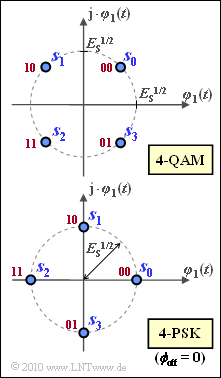Exercise 4.14Z: 4-QAM and 4-PSK
For "quadrature amplitude modulation" ($M$–QAM), an upper bound ("Union–Bound") on the symbol error probability was given in the theory section for $M ≥ 16$:
- $$ p_{\rm UB} = 4 \cdot {\rm Q} \left [ \sqrt{ { E_{\rm S}}/{ N_0}} \hspace{0.05cm}\right ] \ge p_{\rm S} \hspace{0.05cm}.$$
In the theory section, one can also find the "Union–Bound" for "M–level phase modulation" (M–PSK)
- $$ p_{\rm UB} = 2 \cdot {\rm Q} \left [ \sin ({ \pi}/{ M}) \cdot \sqrt{ { 2E_{\rm S}}/{ N_0}} \hspace{0.05cm}\right ] \ge p_{\rm S} \hspace{0.05cm}.$$
In both methods, each signal space point has exactly the same energy, namely $E_{\rm S}$.
From the graph, one can see that for the special case $M = 4$, the two modulation processes should actually be identical, which is not directly evident from the above equations.
The 4–PSK is shown here with the phase offset $\phi_{\rm off} = 0$. With a general phase offset, on the other hand, the in-phase and quadrature components of the signal space points are generally: $(i = 0, \ ... \ , M = 1)$:
- $$s_{{\rm I}i} \hspace{-0.1cm} \ = \ \hspace{-0.1cm} \cos \left ( { 2\pi i}/{ M} + \phi_{\rm off} \right ) \hspace{0.05cm},$$
- $$ s_{{\rm Q}i} \hspace{-0.1cm} \ = \ \hspace{-0.1cm} \sin \left ( { 2\pi i}/{ M} + \phi_{\rm off} \right ) \hspace{0.05cm}.$$
Notes:
- The exercise belongs to the chapter "Carrier Frequency Systems with Coherent Demodulation".
- Reference is made in particular to the sections "Quadrature amplitude modulation" and "Multi-level phase modulation".
- In the above diagram the Gray mapping of the symbols to bit-duples is shown in red.
- All results of the exercise can be checked by simulation with the interactive applet "M–level Phase Shift Keying and Union Bound".
Questions
Solution
- $$s_{{\rm I}i} \hspace{-0.1cm} \ = \ \hspace{-0.1cm} \cos \left ( { 2\pi i}/{ M} + \phi_{\rm off} \right ) \hspace{0.05cm},$$
- $$ s_{{\rm Q}i} \hspace{-0.1cm} \ = \ \hspace{-0.1cm} \sin \left ( { 2\pi i}/{ M} + \phi_{\rm off} \right ) \hspace{0.05cm}.$$
With $\phi_{\rm off} \ \underline {= \pi/2 \ (45^°)}$, we obtain exactly the signal space points of the 4–QAM:
- $$\boldsymbol{ s}_{\rm 0} = (+\sqrt{2}, +\sqrt{2})\hspace{0.05cm},\hspace{0.2cm}\boldsymbol{ s}_{\rm 1} = (-\sqrt{2}, +\sqrt{2})\hspace{0.05cm},\hspace{0.2cm} \boldsymbol{ s}_{\rm 3} = (-\sqrt{2}, -\sqrt{2})\hspace{0.05cm},\hspace{0.2cm}\boldsymbol{ s}_{\rm 4} = (+\sqrt{2}, -\sqrt{2}) \hspace{0.05cm}.$$
(2) Solution 2 is correct: For the 4–PSK, the equation given earlier gives:
- $$p_{\rm S} \le p_{\rm UB} \hspace{-0.15cm} \ = \ \hspace{-0.15cm}2 \cdot {\rm Q} \left [ \sin ({ \pi}/{ M}) \cdot \sqrt{ { 2E_{\rm S}}/{ N_0}} \right ] = 2 \cdot {\rm Q} \left [ { 1}/{ \sqrt{2}} \cdot \sqrt{ { 2E_{\rm S}}/{ N_0}} \right ]= 2 \cdot {\rm Q} \left [ \sqrt{ { E_{\rm S}}/{ N_0}} \right ] \hspace{0.05cm}.$$
(3) Solution 2 is correct:
- The 4–QAM is identical with the 4–PSK (regarding error probability even independent of the phase offset).
- Solution 1, on the other hand, gives the Union Bound of the $M$–QAM in general, where $M = 4$ is used.
- However, since there are no inner symbols in 4–QAM, this bound is too pessimistic.
- The resulting "Union Bound" is then twice as large as the 4–PSK bound.
(4) Here again the second solution is correct:
- In Gray coding, each symbol error results in a bit error if only adjacent regions are considered: $p_{\rm B} \approx p_{\rm S}/2$.
- Furthermore, $E_{\rm S} = 2 \ E_{\rm B}$ is valid. It follows that
- $$p_{\rm B} = \frac{p_{\rm S}}{2} \le {\rm Q} \left [ \sqrt{ { E_{\rm S}}/{ N_0}} \right ] = {\rm Q} \left [ \sqrt{ { 2E_{\rm B}}/{ N_0}} \right ] \hspace{0.05cm}.$$
- As derived in the solution to "Exercise 4.13", even exactly:
- $$p_{\rm B} = {\rm Q} \left [ \sqrt{ { 2E_{\rm B}}/{ N_0}} \right ] \hspace{0.05cm}.$$
- In this derivation, it was used that the 4–QAM can be represented by two orthogonal BPSK modulations (with cosine and minus sinusoidal carriers, respectively).
- Thus, the bit error probability of the 4–QAM and thus also of the 4–PSK as a function of $E_{\rm B}/N_0$ is the same as for BPSK.
